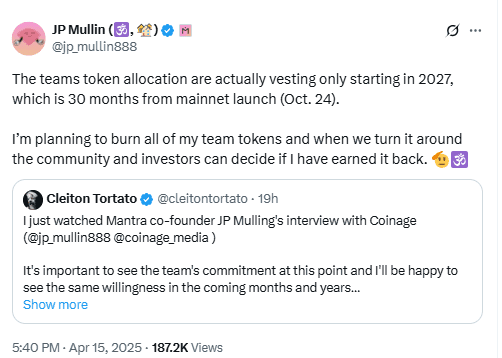“A full forensic investigation, akin to what we saw post-FTX, would be needed to substantiate claims of calculated exploitation,”
Newson said.
Her statement came after Mantra CEO John Mullin announced an $80 million OM token burn to address the fallout. The team also asked centralized exchanges to assist in identifying the cause.

Private OTC Transactions Complicate OM Crash Investigation
Newson highlighted the challenge of tracing over-the-counter (OTC) crypto deals. These transfers are not public, making them hard to track using blockchain tools.
“Public activity is not the full story,”
she noted.
During an interview with Coffeezilla on April 15, Mullin admitted that Mantra engaged in OTC sales totaling $30 million. These transactions bypass traditional exchanges and remain off-record.
One wallet received about 100 million OM tokens. CertiK believes this was likely through market purchases, not direct involvement from Mantra. However, without records, the true source remains unclear.
Blockchain Platforms Can’t Confirm Insider Activity
Mullin denied insider dumping, stating that analytics firm Arkham mislabeled wallet addresses. He disputed the claim that Mantra insiders triggered the price drop.
Newson explained that blockchain analytics platforms like Arkham and Nansen have limits. They show movement but not the context behind transactions.
“To confirm coordinated insider behavior, it would likely require more than just basic wallet tracing,”
she said.
“Without offchain agreements and centralized exchange records, conclusions remain speculative.”
Mullin said on April 16 that Mantra is considering a forensic audit. No outside firm has been hired as of now.
Whale Alert co-founder Frank Weert also addressed the complexity.
“There are ways to get data from the node, but it does not seem to be easy to get a full history,”
he said.
So far, Arkham has not responded to multiple requests for comment.

